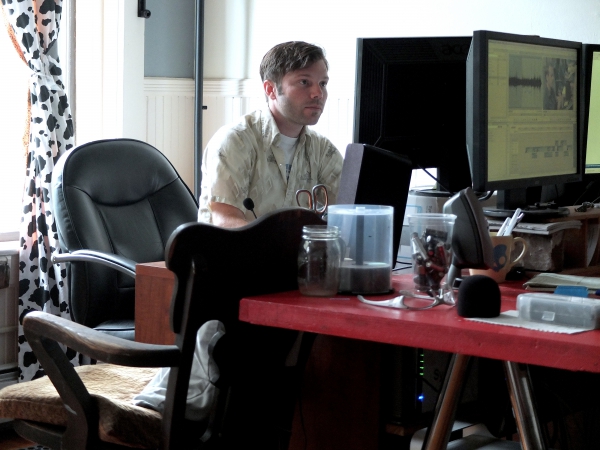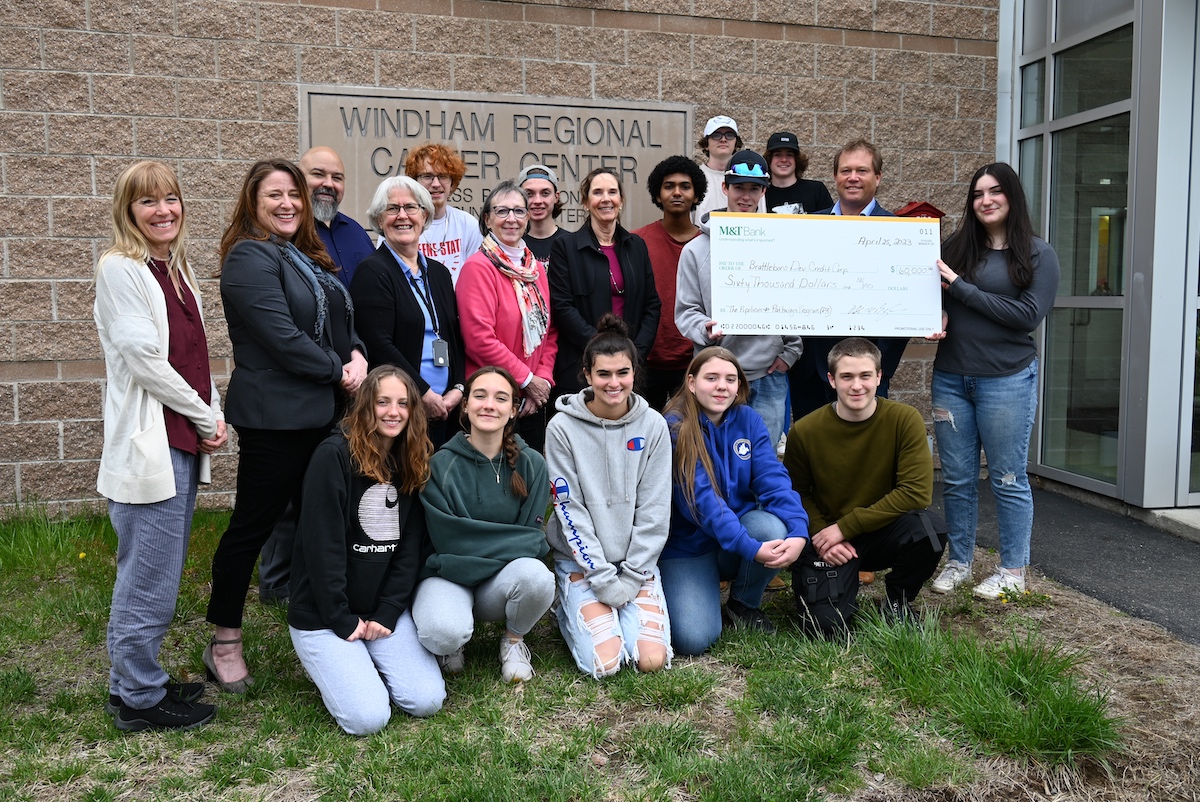
A conversation with Luke Stafford, founder and chief of Mondo Mediaworks
For one would-be newspaper reporter, the medium indeed became the message — and it’s digital
BRATTLEBORO—Call me awestruck, but if there’s ever been a more alluring business name than Cultural Intrigue around our fair town, I don’t know what it could be.
When those two words debuted locally about 23 years ago — on a storefront sign along with Beadniks — I’ll wager that not too many downtown passers-by knew what they signified.
My hunch is they suspected that there was something magical going on in the basement below the bead shop — something, well, intriguing. However, they likely didn’t think it would become a source of pride for the Brattleboro business community, a socially conscious enterprise that would color our world as few others had — or are likely to.
I walked to my meeting with Adam Gebb (pronounced “Jebb”) in the CI headquarters at 35 Frost St., simply to experience the Frost and Elm street scene. I’d driven by the rust-sided structure diagonally across from the New England Youth Theatre hundreds of times over the three years it’s been there. And as many have, I’d wondered what exactly was going on inside.
Putting a label on it, Cultural Intrigue is about wholesale giftware and décor. The company imports all sorts of what you’ll need for a party or a wedding — lighting, table runners, pillow covers, candle holders, vases, tapestries and wall art, ornaments, and a great offering of mercury glass.
It wasn’t until I checked the website that I got it — it’s just about the most colorful website I’ve ever seen. It’s a breath of fresh air. I was clearly primed.
* * *
Jerry Goldberg: How did all this come about?
Adam Gebb: I was at Northeastern University back in the early ’90s, working toward a degree in international marketing. The program took me to Thailand to study ethno-ecology — which means that to learn about the ecology of a landscape, you must study the people as well as the animals and plants that are native to a particular area.
It didn’t take long to discover that the local tribes-people were producing beautiful handicrafts and gorgeous antique silk fabric as an expression of their culture. It also didn’t take long to see that the Thai government was standing in the way of these folks reaping the fruits of their labor.
In other words, there was scant reward to the creators and lots to those in power.
J.G.: Ahh, I’m beginning to see where the name came from.
A.G.: Right. I was hooked — you might say intrigued — by their work. I started buying as much as I could: the fabric, then the handicrafts, and I shipped it back home, hit the road, and began selling it throughout the Northeast.
J.G.: What was it about “here” that made you want to be part of it? Why the Brattleboro area?
A.G.: When you cross the line from Massachusetts into Vermont, you can’t help but notice the beauty of the landscape. Mount Wantastiquet and Pisgah State Park together make up more than 15,000 acres of exciting and gorgeous outdoors right on the edge of town — you can’t beat it.
And then there’s Brattleboro itself. Something about the town seemed right. I could see planting roots here. There was a vibe of creativity. There was an obvious interest in the arts as well as the outdoors.
So I called my friend, Brian Robertshaw and invited him to join me. He did, and we soon hung our shingle on a storefront on Main Street.
J.G.: What kind of environment did you find as you went about establishing your business? Were there obstacles? Did you feel supported?
A.G.: Well, the hardest part, really — no matter where you are — is developing a viable idea for a business. If you have one, I don’t think that starting a small business will present any obstacles you cannot deal with, either on a state or local level.
So Vermont’s reputation of not being business friendly was not an issue — not for a small, start-up business like mine, anyway. Maybe as a business grows that might become more of a factor, but not for a small business.
Again, it’s all about your idea. A good idea will find a way to work and thrive.
J.G.: So you’ve been in business for 23 years now. You have 25 employees. Obviously it’s been working. How’s it going these days?
A.G.: It’s very challenging. The Internet retail world and the technologies that drive companies are changing incredibly fast. So many young people are hot-wired to technology — and the only way to thrive in this Internet retail world is to employ whatever technologies are available today.
I read recently that if a website doesn’t load in three seconds, most young people are gone. So your communication has to automatically size for every device these people are using. As you know, that list goes on and on and is growing.
It’s so fast. Something studied really carefully three years ago will be out of date in a year today — maybe less.
It takes a basketful of technologies to pull off what’s needed. And the basket keeps changing — and fast!
J.G.: So tech is one. What else challenges you today?
As with any business, it’s all about coming up with a clever marketing message, which doesn’t sound so hard.
The wrinkle for Cultural Intrigue is — or, should I say, wrinkles are — that we need to develop messages for 3,000 different products, which fall into categories. We have at least 80 segments, so we need to change our messages for all those groups.
There’s a lot involved. Like life-cycle marketing, which means that some customers buy again every June for their yard, or every November for Christmas. By knowing their patterns, we can approach them based on a timing that is more likely to be fruitful.
It gets pretty challenging to keep up.
J.G.: Let’s talk a bit about operating from the perspective of being in a small town. You mentioned that technology is indispensable to getting your message out there. What was it like when you got here?
A.G.: There was no Internet at that time. Back in the old days, it was trade shows and the fax machines. Even today, small business folks from all over Vermont drive to the Javits Center in New York City to show their stuff.
J.G.: You sound like the consummate entrepreneur. I mean, when you were in Thailand, you noticed an opportunity, and — ping! — a light went on. When you got into this, were there a lot of others doing it?
A.G.: I had competitors. They were a little different, not so much doing what I was doing. We have more now.
J.G.: Was there any history of your kind of wholesale/retail here in the Brattleboro area?
A.G.: Well, Altiplano was here. And Candle in the Night had been here for years.
J.G.: Has the industry changed? Are tastes changing?
A.G.: Tastes are always changing — and whoever isn’t changing will be gone. You must have constant innovation.
J.G.: In the launching of your business, did you make any mistakes? Did you do something along the way that, well, didn’t work the way you thought it would?
A.G.: Hey, mistakes are constant. The question isn’t “Do we make them?” Of course we do. It’s really about making the mistake and trying again and succeeding and trying again and failing. And trying again.
In business, as in life, making mistakes is reality. The question is having successes to balance them.
J.G.: So many folks are afraid to fail — afraid to be wrong.
A.G.: Right. OK, here’s a mistake — and what we did about it. We’d gotten on Google early and rode it big. We were flying. When Amazon came on the scene and started making their presence felt, we wanted no part of them. We’d seen small businesses going under nationwide. So we sat it out.
And Amazon grew and grew and outstripped Google. And we realized that we were already late, and that our cease-and-desist mentality hadn’t worked to our advantage. So we regrouped, reassessed and decided to get into it with Amazon.
We learned that if the survival of our business meant that we had to work with them, we’d better do it. We’re now working real hard to develop a big campaign for Amazon.
J.G.: Let’s talk about the Brattleboro area and your ability to sustain a business here. We hear lot about there being a shortage of folks around who are qualified to do the available work. How are you today about building a team that’s up to the task?
A.G.: It is sometimes difficult to find workers who have the skills we want. We’re talking cutting-edge digital marketing concepts, and we can’t always find people here who get that.
But we’ve hired by using the Internet. As a matter of fact, we have an employee who lives in California. You don’t have to live here.
We’ve also found that some people just want to move to Vermont, maybe for the same reasons I had. So we dip down into western Mass. and say, “Come on up!”
J.G.: You put up the building. We all saw it happen. It’s one of the more unique pieces of architectural art in town, and probably in the whole of southern Vermont.
How did the concept of this building come to you?
A.G.: The building has 19,000 square feet, most devoted to the warehouse section. As to its aesthetic, I wanted it to look like it fit the look that’s so characteristic of downtown Brattleboro. So first, it had to look old, and color-marry well with all the brick.
Second, I wanted the siding to not need replacing for a long time, so I did a lot of research and found this Corten siding — a stabilized rust that will last for 80 years.
Third, it had to be a totally satisfying experience: good looking on the outside and beautiful and comfortable inside.
And finally, we wanted it to be energy efficient. We were told by experts that depending on the building choices you make, your annual heating could range from between $7,000 and $36,000. We went for the top of the line, and the result is that we’re extremely energy efficient.
And, yes, our annual heating bill is $7,000.
J.G.: Is there any part of the Cultural Intrigue story I haven’t brought up that you’d like to mention?
A.G.: We think long and hard about the toxins that are created by manufacturing. There are often choices to be made, ways to reduce those toxin levels. Of course, these may result in slightly higher cost, but our intention to be less toxic trumps that concern.
So we invest in design, adding value that way. We want our legacy to be responsible.
And there’s our color story. We work hard to be trend-setters, and we find others copying us. We spend a lot of time innovating and others spend a lot of time copying us.
I’d rather be us.
J.G.: One of the beautiful parts about the Brattleboro area is that it’s on a major interstate — with three exits yet. Since your business depends on easy shipping — easy in and out — does that help?
A.G.: Hey, all we need at Cultural Intrigue is an Internet connection and a UPS truck, and we can sell anywhere in America!
J.G.: So let’s say you were at a party and some dude who knew that you had a small business here asked you for advice on starting one — and you liked the idea. What advice would you give?
A.G.: Again, it all comes down to the idea. If you have a good one, if you’ve done your homework and your business is viable, and if southern Vermont does it for you, nothing should stand in your way.
I guess it comes down to this: Are the people here the kind of folks you like to be around, and does the landscape touch your soul?
If the answers are “yes” and “yes,” then go ahead. Hey, give me good people and a beautiful landscape, and I’m ready.



